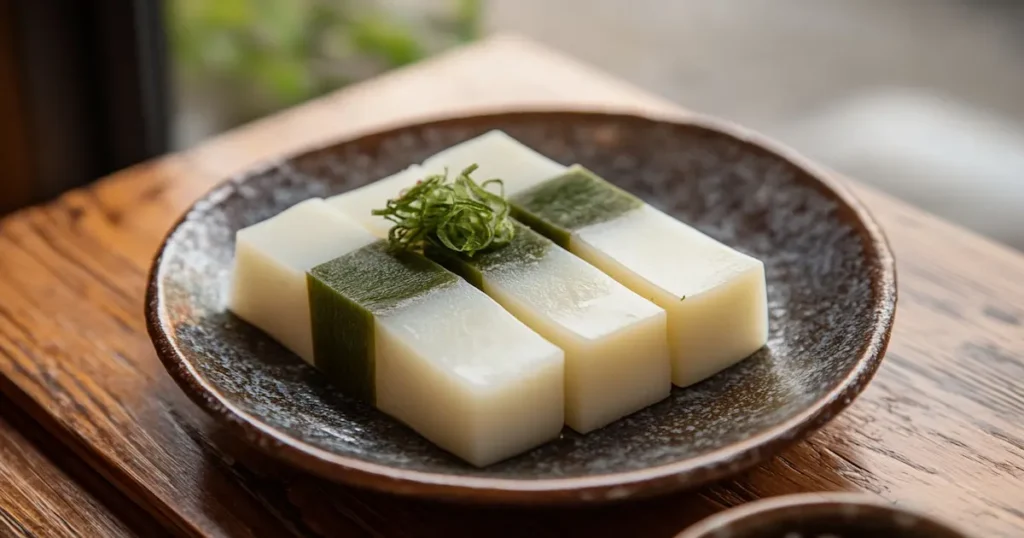Introduction
Yokan, a traditional Japanese dessert, is one of those delights that perfectly encapsulates the elegance and simplicity of Japanese cuisine. Although it may seem like just a simple jelly dessert, yokan holds a rich history, profound cultural significance, and a unique texture that sets it apart from other sweets. It’s not just a treat; it’s an experience, often enjoyed during tea ceremonies or as part of celebrations and festivals. With its firm, jelly-like consistency and the natural sweetness of red bean paste, yokan offers a delicate balance of flavor and texture that appeals to both the palate and the senses.
But beyond its understated appearance, yokan is a dessert that carries centuries of tradition. Made primarily from red bean paste (azuki beans), agar-agar, and sugar, it has been enjoyed in Japan for hundreds of years, often as a symbol of prosperity and good fortune. Whether you’ve tried it at a Japanese tea ceremony or stumbled upon it in an Asian market, yokan is likely to leave a lasting impression.
In this article, we’ll explore everything you need to know about yokan – from its history and regional variations to how you can easily recreate this delicious dessert at home. If you’re curious about the ingredients that give yokan its distinct texture, or if you want to learn how to make this unique dessert yourself, we’ve got you covered. Whether you’re an experienced cook or a novice in the kitchen, our step-by-step guide will help you master the art of making yokan and enjoy this iconic treat in the comfort of your own home.
The Origins of Yokan
The History of This Japanese Dessert
Yokan has a long history in Japan. Initially, it was a savory dish made with meat and agar-agar, but over time it evolved into the sweet version that we enjoy today, featuring azuki beans as the key ingredient. The transition to sweetness occurred during the Meiji period (1868–1912). It quickly became popular and is now an essential part of Japanese tea culture.
From Traditional to Modern Flavors
While the classic version of this jelly dessert was traditionally dense and savory, the modern versions include a variety of flavors. These can range from matcha, chestnuts, to sweet potatoes, but the foundation of red bean paste has remained unchanged in most recipes.
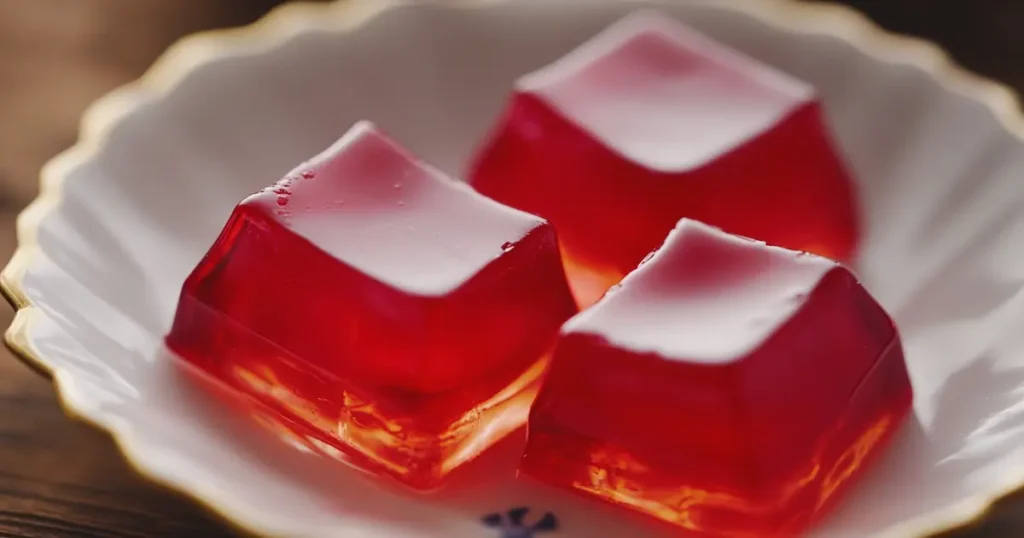
Key Ingredients for This Japanese Jelly Treat
Main Ingredients
To make this sweet treat, you’ll need the following:
- Red Bean Paste (Anko): The paste made from azuki beans is the base of this dessert. You can purchase it pre-made or prepare it yourself by cooking the beans with sugar.
- Agar-Agar: This plant-based gelling agent is essential for achieving the jelly-like texture. Agar-agar is derived from seaweed and is used in various Asian desserts.
- Sugar: Sweetens the mixture, balancing the earthy flavor of the beans.
- Water: Helps dissolve the agar and combine all the ingredients.
- Salt: A pinch of salt helps cut through the sweetness of the red bean paste.
Optional Flavor Variations
- Matcha Powder: Adding matcha gives the dessert an earthy, green tea flavor, which pairs beautifully with the sweetness of the red beans.
- Chestnuts: Roasted chestnuts provide texture and a nutty flavor, adding depth to the dessert.
- Sweet Potatoes: Mashed sweet potatoes create a creamy texture and provide natural sweetness.
Step-by-Step Instructions for Yokan
Prepare the Red Bean Paste
- Rinse the Beans
Begin by rinsing the azuki beans thoroughly under cold water. This helps remove excess starch and any impurities. It’s important to rinse the beans well to ensure a smoother paste later on. - Cook the Beans
After rinsing, place the beans in a large pot and cover them with water. Bring to a boil and let them cook for about 5-10 minutes. After boiling, discard the water. This helps reduce the beans’ bitterness and gives the paste a cleaner taste.
Then, fill the pot with fresh water and bring the beans to a simmer. Let them cook for 1.5 hours or until they are tender and easily mashed. Keep an eye on the water level and add more if necessary. - Mash the Beans
Once the beans are soft and fully cooked, drain any excess water and mash the beans using a potato masher, food processor, or blender. Mash them until you reach a smooth and thick paste.
Add sugar to taste, usually around 1/2 cup, but you can adjust the sweetness depending on your preference. Stir the sugar in until it is fully dissolved. You can also adjust the texture at this point by adding a bit more water if the paste feels too thick.
Dissolve the Agar-Agar
- Prepare the Agar
In a separate saucepan, dissolve agar-agar powder in 2 cups of water. Stir the mixture well to ensure the agar powder is evenly distributed.
Bring the mixture to a boil over medium heat while stirring. Once it begins to boil, reduce the heat slightly and allow it to simmer for 2-3 minutes. This ensures that the agar dissolves completely and no clumps remain.
Combine the Ingredients
- Mix the Paste and Agar
Once the agar has fully dissolved, gradually combine it with the red bean paste. Pour the hot agar mixture slowly into the red bean paste while stirring constantly. This will ensure that the agar is evenly distributed throughout the paste, giving the dessert its firm texture. - Pour into a Mold
After thoroughly mixing, pour the resulting yokan mixture into a mold (you can use a shallow baking dish or silicone mold). Smooth the top with a spatula for an even surface.
Allow the mixture to cool at room temperature for about 30 minutes, and then transfer it to the refrigerator. Let it chill for 2-3 hours, or until it has completely set. The dessert should be firm to the touch and hold its shape when cut.
How to Serve Your Yokan
Let It Set
Once the mixture is in the mold, allow it to cool at room temperature for about 30 minutes. Then refrigerate it for 2-3 hours, letting it firm up and set completely.
Slice and Enjoy
Once set, remove the Yokan from the mold and cut it into slices. This dessert is best served chilled and is perfect with a warm cup of green tea.

Variations to Try
Matcha Yokan
For a unique twist, add matcha powder to your red bean paste before combining it with the agar. This variation provides a beautiful green color and a slightly bitter flavor that balances the sweetness of the beans.
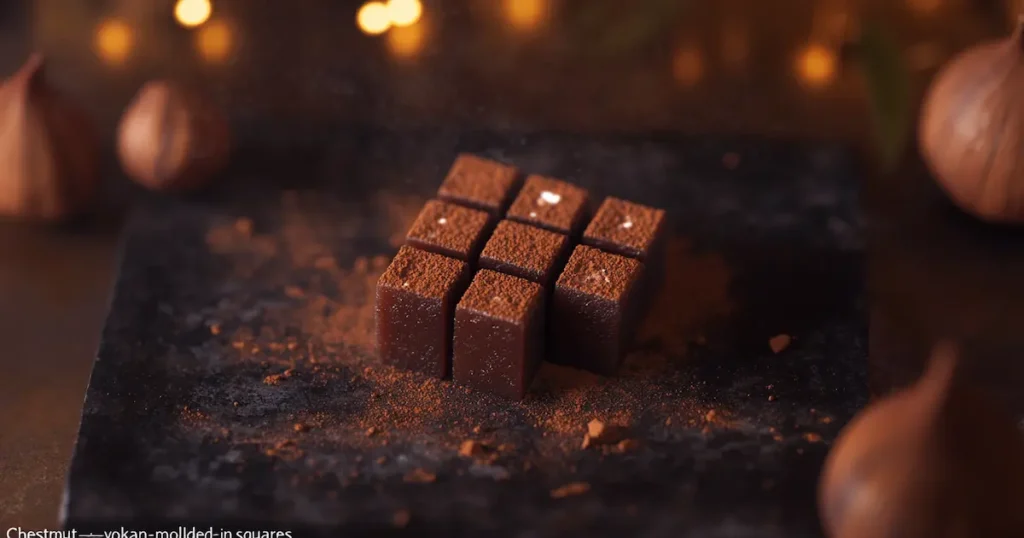
Chestnut Yokan
For a richer variation, try adding chestnuts to the red bean paste. This combination is particularly popular during the colder months, when chestnuts are in season.
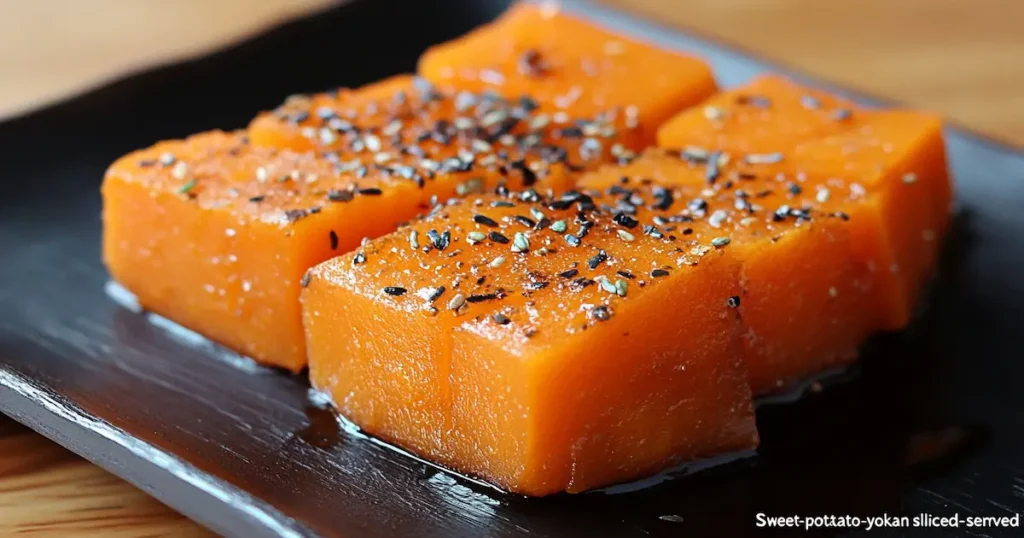
Sweet Potato Yokan
For a creamy and smooth texture, consider adding mashed sweet potatoes to the red bean paste. This variation is naturally sweet and adds depth to the flavor.
Troubleshooting Tips
Correcting Texture Problems
If your Yokan is too soft, you may not have dissolved the agar completely, or there might not be enough agar in the mixture. On the other hand, if it’s too firm, reduce the agar the next time you make it.
Ensuring a Smooth Red Bean Paste
For a silky smooth paste, blend the beans thoroughly or pass them through a fine mesh strainer. This ensures the perfect texture for your dessert.
Health Benefits of Yokan
Although this dessert is sweet, it has some health benefits thanks to its main ingredients. Azuki beans are packed with protein, fiber, and antioxidants. Agar-agar is low in calories and provides fiber, making this dessert a healthier option than many other sugar-laden sweets.
A Healthier Dessert Option
Compared to many Western desserts, which are high in cream and fat, Yokan is a lighter option. It’s perfect for those looking to indulge in a sweet treat without excess calories.
Frequently Asked Questions
Q1: How long can I store Yokan?
Yokan can be stored in the refrigerator for up to 5 days. Ensure that it is wrapped tightly to prevent it from drying out. You can also freeze it for longer storage, but freezing may affect the texture.
Q2: Can I use other types of beans?
While azuki beans are traditional, you can experiment with other beans, such as black beans or kidney beans, for different flavors and textures.
Q3: Can I make a sugar-free version of Yokan?
Yes, you can substitute sugar with sweeteners like erythritol or stevia. However, this may alter the texture slightly, so you may need to adjust the agar accordingly.
Conclusion
Yokan is much more than just a dessert. It’s a symbol of Japanese culinary tradition, a reflection of the country’s deep respect for simplicity and balance. Over centuries, this humble jelly-like treat has evolved and adapted to different tastes, yet it has always stayed true to its roots, offering a delicate sweetness that complements the subtlety of Japanese tea ceremonies. Whether enjoyed in the traditional setting of a formal gathering or as a simple, soothing treat at home, yokan’s timeless appeal continues to resonate with people across generations.
Making yokan at home is a wonderful way to connect with Japan’s rich food heritage. The process itself is meditative, offering a chance to slow down and appreciate the precision and care involved in crafting something so simple, yet so elegant. When you prepare yokan, you’re not only creating a dessert; you’re also embracing the philosophy of wabi-sabi—the beauty of imperfection and the appreciation of the transient nature of life. Each slice of yokan, with its smooth texture and natural sweetness, is a little piece of this philosophy, crafted by your hands and enjoyed in the present moment.
The versatility of yokan also makes it a fun dessert to experiment with, allowing you to infuse different flavors such as matcha, sweet potato, or chestnut into the base, adding a personal touch to this traditional recipe. Whether you’re sharing it with friends over a cup of tea or serving it at a special occasion, yokan always brings an element of elegance and mindfulness to the table.
In today’s world, where we are constantly bombarded with fast-paced lifestyles and processed foods, taking the time to create something from scratch, like yokan, is a reminder of the simple pleasures that can be found in nature’s ingredients. So, the next time you find yourself in the kitchen, consider making yokan as a way to reconnect with the art of Japanese dessert-making. Not only will you be savoring a delicious treat, but you’ll also be honoring a piece of Japan’s culinary heritage that continues to inspire and captivate people around the globe.
In the end, yokan is more than just a dessert; it’s an experience, a way to pause, reflect, and appreciate the beauty in simplicity. Whether you’re enjoying it as part of a quiet tea ceremony or sharing it with loved ones, yokan reminds us that sometimes, the simplest things in life are the most satisfying..
Final Thoughts on Yokan: A Timeless Japanese Delicacy
Yokan is more than just a dessert—it’s a reflection of Japanese culture, craftsmanship, and tradition. From its humble origins as a savory dish to its transformation into the beloved sweet treat we know today, this jelly-like confection has stood the test of time. Its simplicity in ingredients yet richness in flavor makes it a favorite among dessert lovers worldwide.
Whether you prefer the classic red bean paste version, a matcha-infused twist, or a chestnut or sweet potato variation, there’s no shortage of ways to enjoy this versatile sweet. The delicate balance of sweetness, firmness, and smooth texture makes it a perfect companion to a warm cup of tea, offering a moment of calm and indulgence.
By making this dessert at home, you not only get to enjoy an authentic taste of Japan, but you also get the opportunity to experiment with flavors, textures, and presentations to suit your personal preferences. With just a few ingredients and simple steps, you can create a stunning and delicious treat that impresses family and friends.
If you’re a fan of traditional sweets, Japanese cuisine, or simply love trying new desserts, Yokan is a must-try. So why not give it a go? Whether you’re making it for a special occasion, as a snack, or to complement your tea time, this dessert is sure to delight your taste buds and introduce you to the elegance of Japanese confectionery.
Ready to Try Yokan?
Now that you have all the knowledge and steps needed to make this dessert, it’s time to head to the kitchen and start crafting your very own homemade Yokan! Feel free to get creative with different ingredients and flavors to make it uniquely yours.
If you enjoyed this guide, share your experience with us! Have you tried making Yokan before? What flavors do you love the most? Let us know in the comments!
Table of Contents
table of contents
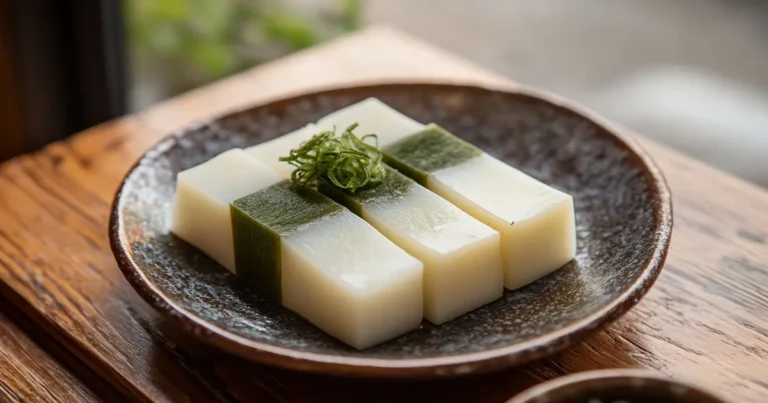
Yokan: A Traditional Japanese Jelly Dessert
Yokan, a delicious Japanese dessert made from red bean paste and agar-agar, offers a sweet and satisfying treat.
- Total Time: Approximately 4 hours and 30 minutes
- Yield: 8–10 servings
Ingredients
- Red Bean Paste (Anko): 2 cups (can be purchased pre-made or homemade by boiling azuki beans and sweetening them with sugar)
- Agar-Agar: 2 teaspoons
- Sugar: 1/2 cup (can adjust depending on sweetness preference)
- Water: 2 cups
- Optional Flavorings:
- Matcha powder (for a green tea flavor, 1-2 teaspoons)
- Chestnut paste (for a richer, nutty variation)
Instructions
Prepare the Red Bean Paste (Anko)
- If using homemade anko, cook azuki beans in water until tender, then mash and sweeten with sugar. For a smoother consistency, blend the paste.
- If using pre-made anko, ensure it is smooth and without any large bean chunks.
Dissolve Agar-Agar
- In a medium saucepan, combine the water and agar-agar. Stir well and bring to a boil over medium heat.
- Reduce the heat and simmer for about 5 minutes, making sure the agar-agar is completely dissolved.
Combine Ingredients
- Add the red bean paste to the dissolved agar-agar mixture, stirring to combine thoroughly.
- If you’re adding flavorings like matcha or chestnut paste, mix them into the paste now.
Set the Yokan
- Pour the mixture into a mold or a baking dish lined with plastic wrap. Use a spatula to smooth the top.
- Allow the mixture to cool at room temperature, then refrigerate for 3–4 hours, or until set. The texture should be firm but smooth.
Serve
- Once set, remove from the mold and cut into rectangular or square blocks. Serve chilled or at room temperature.
Notes
- Storage: Yokan can be stored in an airtight container in the refrigerator for up to 5–7 days.
- Serving Suggestions: Yokan is often served with a cup of green tea or as part of a traditional Japanese tea ceremony.
- Optional Variations: You can add additional flavorings like vanilla extract, matcha, or chestnut paste for different tastes. Mizuyokan (a softer version) can be made by increasing the water content slightly.
- For a Vegan Option: Ensure that the red bean paste is free of any animal-derived ingredients (some commercially made anko may contain animal products like lard).
- Prep Time: 20 minutes
- Cook Time: 10 minutes
- Category: Dessert,
- Method: Boiling, Mixing, Cooling
Nutrition
- Calories: 120 kcal
- Sugar: 20g
- Fat: 0g
- Carbohydrates: 27g
- Fiber: 5g
- Protein: 3g
Keywords: Yokan
